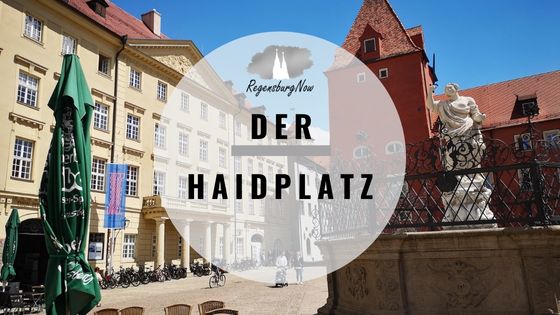
The Haidplatz
THE HAIDPLATZ IN REGENSBURG!
Regensburg has many beautiful squares to offer. One of the most beautiful is certainly Haidplatz, in the middle of the old town. Our guest author Rainer Krämer tells us the story of Haidplatz here.
To clarify right at the beginning: the name does not come from the “pagan Craco”, who, according to Regensburg city legend, fought there in the early 900s with the Regensburg Dollinger for city rule. Why should a square be named after a loser? The gleaming golden cross in the hands of the brave Hans Dollinger is said to have dazzled the “Hun giant” so much that he could be defeated. The “Haide” simply refers to an uncultivated field, a meadow. And such a large fallow meadow was still located in front of the western, undestroyed Roman wall until the mid 900s. Before that, this area was a suburb, a “Canabae” from Roman times until 450 A.D. It was only from 920 onwards that the buildings scattered to the west of the former Roman fort up to the Arnulfgraben, i.e. today’s Weißgerbergraben, were included in the so-called 1st city extension. This measure ensured, among other things, that the future prosperous trading city could now expand unhindered to the west, including the northern bank of the Danube. The former “Heide” was left as a large open space in the middle of the residential castles that were now being built to the side, as a place was needed for strolling, riding, arguing, head-butting, market events and other large spectacles. Haidplatz became the new central hub, just a stone’s throw away from the town hall complex.

Logically, magnificent patrician castles and municipal administration buildings were now built all around. The city weigh house was moved there from the Römling, and the city mint and fencing school were now close by. The city guard’s quarters were also located there, as were the court rooms. In 1541, the famous (but inconclusive) religious debate between Johannes Eck (Catholic) and the reformer Melanchton (Protestant) was held with great fanfare in the large hall of the Neue Waag. Just one year later, Regensburg declared its Protestant faith. Nothing but expenses…
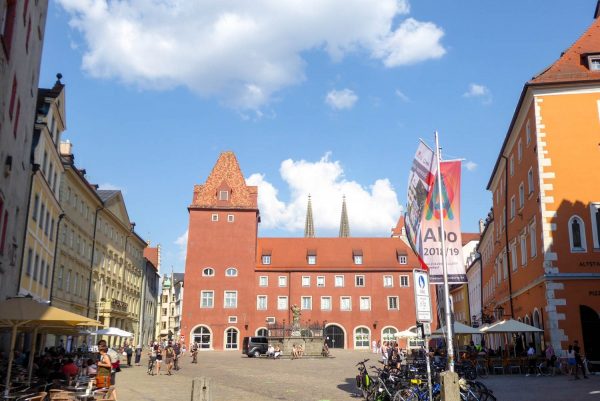
Streets/alleys now led from all sides to and from Haidplatz, whose large main street led to the Rouzan-Burgtor, the former western city gate at the junction with today’s Arnulfsplatz. Fragner (merchants) and Gave-people (overland traders), jugglers and musicians bustled about on the large open space, while the neighboring inns and wine taverns provided food and drink. Stefan Notangst was not only an extremely wealthy but also a “social” local wine tavern keeper who, together with his no less wealthy friend Kastenmayr, founded a “Bruderhaus” (retirement home) for craftsmen who had fallen on hard times through no fault of their own. The families of Woller (Waller), Hiltprant, Sittauer, Runtinger, etc., also occasionally did good with their wealth. They also owned buildings there, as did the craftsmen with their guilds who worked in the adjacent alleyways. The first part of today’s Rote Hahnengasse from Haidplatz to the junction with Hinter der Grieb was called “bei den Flaschen” in the High Middle Ages. This means that the special guild of pansmiths, in this case copper bottle makers, was active here.
Haidplatz is dominated by the mighty residential castle “Goldenes Kreuz”, which was assembled from several buildings. Only emperors, kings, important and unimportant aristocrats and politicians could afford to stay there from 1500 to the mid-1800s in what was then Germany’s most famous luxury hotel and restaurant, and to shake a leg on the swinging dance floor. In 1546, Emperor Charles V, who was already a little grey, must have liked it so much that he fell in love with the chorus girl Barbara from the Blomberg’s Gürtlermeister in the Tändlergasse.
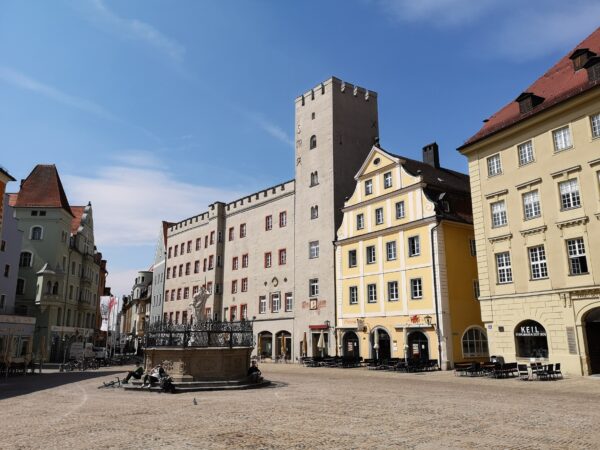
The patricians of the Weltenburger family, later the Zeller, Thuner and Fugger von Reh families, right up to the S.M.R. (Senta and Max Rief) at the beginning of 1950, were the owners of this large ensemble of buildings. The so-called Justitiabrunnen in the middle of Haidplatz is a constant reminder of the administration of justice. The place of execution, where the head of the brave General Hans Ulrich von Schaffgotsch fell in 1635 due to a miscarriage of justice, was only one of at least five places of execution in the city. The “world-famous” surgeon, juggler and tightrope walker Charles Bernovin also fell to the ground there in 1763 when, equipped with rockets, he tried to whizz from A to B on a rope. Only this time it went wrong.

From 1750 onwards, the influential von Dittmer dynasty, which emerged from a small banking house and whose most worthy representative made it to the position of Regensburg mayor and Bavarian Minister of the Interior, had more success. His Thon-Dittmer-Palais, also originally composed of two or three buildings, was embellished in the early 1800s by d’Herigoyen, the court archtiect in Dalberg’s service, who is well known to us Regensburgers. Particularly worth seeing is the impressive inner courtyard surrounded by arcades, which is also used for performances and festivities.
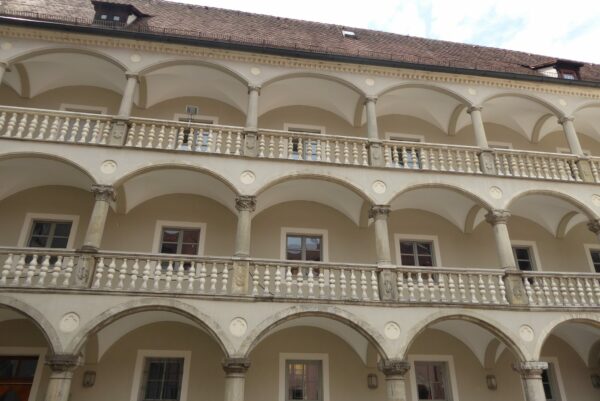
In 1654, Otto von Guericke (inventor of the air pump) demonstrated his vacuum spheres (Magdeburg hemispheres) to great amazement and applause during the Emperor’s stay at the Perpetual Diet. Even then, rattling was part of the trade. Did you know that the workshop of the “Schwertfeger” (cutler) Keil, originally on the Römling, has been operating there since 1806? And in the early 1900s, Regensburgers could still buy hay and straw to fill their sleeping mattresses at the “Neuer Kornmarkt”, as the Haiplatz was called a good 100 years ago… Vor der Grieb, Hinter der Grieb, are the names of the narrow alleyways that lead to the former pits/envelopes of the Vitusbach. Whereby “Hinter” is linguistically derived from “Inter”, which means “by”. Stroll around Haidplatz with your eyes wide open, look for a sunny spot, e.g. “inter aurem crucem” (by the Golden Cross), take a look at the Justitia Fountain and the Neue Waag. You might also find the little mouse on the Neue Waag by the Witt music store. It is said to bring good luck if you stroke it…
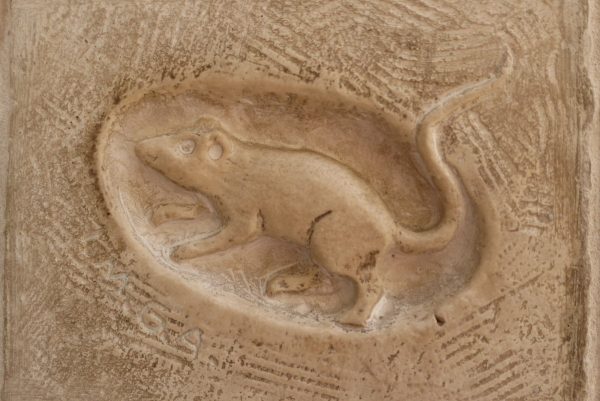
You can find out more about Haidplatz and its special features here:
(unpaid and uncommissioned advertising due to naming)
A guest article by Rainer Krämer. Rainer Krämer’s books, such as
1400 Regensburg street names (Softcover / 34,50 € )
Regensburg History 100-1700 Volume 1 (Softcover / 29,50 €)
Regensburg History 1800-2000 Volume 2 (Softcover / 29,50 €)
or The Great Regensburg History Quiz (Softcover / 19,50 €)
are available in bookshops.


(unpaid advertising due to naming and shaming)
Our excursion tips on Facebook:
Do you already know our Facebook group “Excursion tips in and around Regensburg plus Upper Palatinate” with more than 22,000 members? Click here for the group.
RegensburgNow.de has over 40,000 readers per month and is a site of the RegensburgNow agency
If you are interested in advertising on RegensburgNow, please write to us at mail@regensburgnow.de
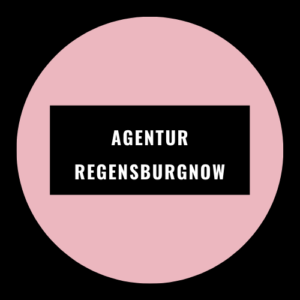
Don’t miss a thing! Subscribe to our newsletter:
Want more tips? Then please click here:















